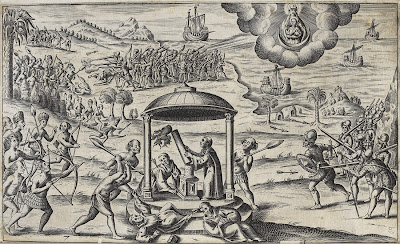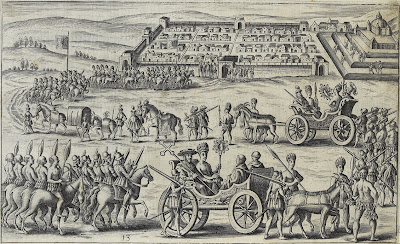"If your highness may be pleased to have the Holy Gospel preached to the people in those provinces with the necessary zeal, God our Lord will be served and many idolatries and notable sins which the devil has implanted among the natives will be eradicated. Thus having succeeded in this holy purpose your royal crown will be served by an increase of vassals, tributes, and royal fifths." - Baltasar Obregón to the king, Mexico City, 15841

















[click for full size versions - a couple have had some age related artifact cleaned]
'Nova Typis Transacta Navigatio. Novi Orbis Indiae Occidentalis' from 1621 is online at the Digital Library of Rare Books at the University of São Paulo in Brazil (click book image to open an easy viewing window; click on book pages to enlarge).
This extraordinary and very rare book weaves fact and fantasy as it narrates the adventures of a group of Benedictine missionaries led by Father Bernardo Buil, who accompanied Christopher Columbus on his 2nd voyage to the New World.
In an audacious editorial move, the author is billed as Honorius Philoponus and an exceedingly complimentary dedication to the Abbot of Seitenstetten in Austria, Caspar Plautius, opens the text. The thing is, Honorius Philoponus is actually a pseudonym for - you guessed it - Caspar Plautius. There's nothing like writing your own reference!
A similarly extravagant plot move involved blending the legend of the 5th century voyage to magical islands by the Irish Saint Brendan with the 1493 Columbian expedition. In the 4th image from the top, St Brendan is depicted celebrating Easter mass on the back of a whale, Jasconius, as part of the quest for the Promised Land of the Saints, during which, some say St Brendan discovered America. At the top of that image is an island named after St Brendan, a mythical cartographic oddity, often included on world maps up until the 18th century.
As with many of the engravings (all attributed to Wolfgang Kilian) the St Brendan/whale image has evocative symbolic meaning - having the Easter mass on the whale as a major pictorial element dominating the map suggests that religious devotion combined with mastery of the oceans and nature made discovery and conquering of the New World an inevitability of divine providence.
The rather theatrical depiction of Columbus (3rd last image) was in fact copied from an illustration by Theodore de Bry of the Conquistador, Francisco Pizarro - this despite Plautius asserting in his dedication that the de Bry voyage books circulated falsehoods.
Although prone to embellishment (some of the engravings obviously hint at the preoccupation with cannibalism, native barbarity and assumed satanic beliefs), the "work is nonetheless filled with authentic details of Caribbean customs, agricultural products, local flora and fauna, and arts". It includes one of the earliest illustrations of the potato plant as well as a musical score for native chanting.
- The listing at the International League of Antiquarian Booksellers gives the best overview and includes more details about the significance of the imagery.
- A sample of the engravings as they appear in the book.
- The St Brendan legend in the Utopia exhibition at NYPL [en français: BNF].
- 'St Brendan's Isle, Or: Who Really Discovered America?'
- 'Potato' by John A Mazis.
- Bernardo Buil.
- Wolfgang Kilian.
- Christopher Columbus.
- 1That quote has no direct connection to the Plautius book, save for the sentiment.
Tidak ada komentar:
Posting Komentar